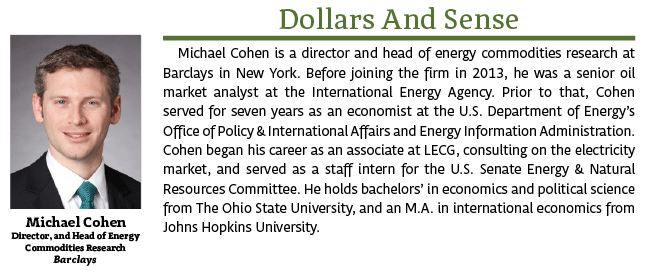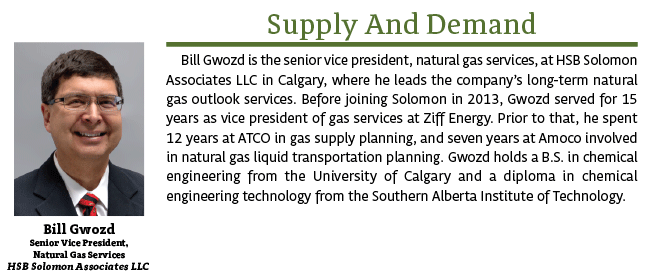
2016 Price Outlook
Analysts See Reasons for Optimism
Editor’s Note: As the calendar flips, oil and gas companies are not exactly sorry to see 2015 exit stage left. In an industry built on optimism, operators are turning the page to a new year, hoping to find a fresh outlook with renewed business opportunities in the months ahead.
Everyone knows the back story: The advent of tight oil and shale gas development ignited a historic resurgence in domestic activity. But after years of impressive growth in crude oil output, it appears the tide is turning in dramatic fashion. The U.S. Energy Information Administration was estimating that by year-end, U.S. crude production would have dropped 500,000 barrels a day since hitting a peak of 9.6 million barrels a day last spring. It forecasts the loss of another 600,000 bbl/d through the first three quarters of 2016.
U.S. natural gas production has followed a different script, with EIA data showing a year-to-year net increase, at least through third quarter 2015. But with gas rig counts sliding 45 percent since the start of last year and prices on the New York Mercantile Exchange dipping to multiyear lows at the onset of the winter heating season, there is plenty of head wind to the industry’s ability to continue to ramp up gas production in the new year.
So the stage is set, the actors are in place, and the curtain has been lifted on 2016. After all the twists and turns that have played on the national and international stages the past few years, where does the story line go from here?
The outlook remains as uncertain as ever, but a growing chorus of voices is starting to see a turnaround on the horizon. From Michael LaMotte, senior managing director at Guggenheim Securities, to Mark Papa, a partner at Riverstone Holdings and former chief executive of EOG Resources, several industry and financial sector experts are pointing to fundamentals at play that bode well for improved upstream business conditions down the road.
Accordingly, AOGR presented a series of questions to a panel of market analysts to get their insights on oil prices, the extent of the U.S. oil production decline, and prospects for North American natural gas over the near to intermediate terms. Panelists are Michael Cohen, director and head of energy commodities research at Barclays in New York; Jodi Quinnell, manager of crude oil analytics at Genscape Inc. in Boulder, Co.; and Bill Gwozd, senior vice president, natural gas services, at HSB Solomon Associates LLC in Calgary.
Questions are in italics, followed by the panelists’ responses.
Dollars And Sense:
Stronger Oil Price Required
Q: The past 15 months have been as trying for the U.S. industry as any stretch in recent memory. With West Texas Intermediate prices falling 50 percent year to year, oil rig counts collapsed to their lowest levels in five years in third quarter 2015. But analysis from Barclays indicates the price cycle may have reached bottom, and that oil prices are poised to begin ticking higher. What are your WTI and Brent price outlooks for 2016? What are the low-end, high-end and most-probable pricing scenarios through 2020?
MICHAEL COHEN: We see WTI at $56 and Brent at $60 for 2016. We expect prices will remain around late-2015 levels in the first quarter, then gradually improve over the course of the year as the overall market balance begins to tighten.
There is not always a tight correlation between stock builds and prices, so how the market views the fundamentals for 2017 likely will play a bigger role in price formation than those in place for 2016. With that in mind, we expect the market to come back into balance by fourth quarter 2016. In other words, global supply will equal global demand.
We expect non-OPEC supply to decline by about 500,000 bbl/d next year, and that demand will increase by about 1.2 MMbbl/d, in contrast to demand in 2015, where the increase likely was in the range of 1.7 MMbbl/d-1.8 MMbbl/d.
At the same time, supply from the Organization of the Petroleum Exporting Countries is likely to increase by around 1.0 MMbbl/d. Some of that is going to come from a return in supplies from Iran, but it also is likely to result from elevated supply from both Saudi Arabia and, to a much smaller degree, Iraq.
Prices may stay (in the $40 range) or go even lower, if enough supply-side issues occur. The two biggest potential issues are whether Libyan production returns and averages in excess of 1 MMbbl/d, and whether Iranian supply increases more than 500,000 bbl/d.
On the demand side, a scenario that involves a lower price is one in which Chinese commodity demand continues to decline in excess of the market’s expectation, or winter heating oil and other fuel demand is muted as a result of El Niño. These are not part of our base case, but if they occur, they could create additional price pressure.
Q: Can you summarize Barclays’ rationale for strengthening oil prices incrementally, and why a continuation of $40-$50 oil invariably would make the market susceptible to supply shortages and price spikes? In keeping, what are your expectations for North American and global capital spending in 2016, and what does that imply for supply longer term?
COHEN: After analyzing the break-evens in the shale plays, we do not see a $40-$45 price as adequate to sustain continued growth in shale production for the medium term. With shale supply flat or in decline, the growth from other supply sources will be insufficient to fill the void created by production declines and incremental demand growth.
Higher prices will be necessary to support the activity that fills that void. Some oil and gas producers have reported they can grow production even when WTI is below $50. That may be true at the moment, but current activity is largely a function of cyclical cost deflation. Although oil and gas companies continue to make structural improvements, as rig activity increases, we expect service costs (and therefore, break-even prices) to recover.
Reduced capital expenditures also will support prices. CAPEX fell 25-30 percent in 2015 and should fall an additional 20 percent in 2016. There are a number of projects that should have been coming on line in 2020-21, but likely will not receive a final investment decision (FID) in 2016. We are seeing a handful of the most attractive projects move forward, but certain projects in Canada, the deepwater Gulf of Mexico, Angola, Nigeria and Brazil that fall on the far end of the cost curve are unlikely to receive approval.
This will create a supply “void” that will have to be met, eventually causing prices to move higher to develop these supplies to fill that void.
The delays in FIDs will begin to have a major effect on prices after 2020. In the short term, it is more important to consider the impact low oil prices have on maintenance and operating expenses. When investment falls, mature field decline rates accelerate. For example, the decline rate in existing fields went from 2.0 percent to 5.0 percent in the early 1990s, from 3.0 to 5.5 percent during the 1998-99 downturn, and from 4.0 percent to 6.0 percent in the 2008-09 depression. In our view, that will tighten the market sooner than many expect.
Q: According to IEA, global oil demand grew by a five-year high of 1.8 MMbbl/d in 2015 and is projected to expand another 1.2 MMbbl/d this year. Adding 3.0 MMbbl/d in new demand is certainly welcome news to producers. What are the key drivers behind this growth, and what specific demand-side factors support higher-price expectations over the next three to four years?
COHEN: The first source of incremental demand is in the Middle East. The growth there comes from infrastructure spending and expanding populations, all of whom are demanding more energy, and specifically, more oil. Demand will be lower than otherwise because Saudi Arabia is building natural gas-fired power plants to limit its oil consumption, which has been very high for the past couple years.
Temperatures in the Middle East have been high, especially during the summer, which has increased power usage. Oil’s share of the power sector fuel mix is growing, especially in Iraq. The country cannot meet its power requirements, so it is relying more and more on diesel.
The final source of Middle East demand is Iran. As sanctions are removed, an increase in Iranian economic activity will partially offset the additional supply it brings to the global market.
Most of this economic activity will involve investments in infrastructure, including refining capacity and petrochemical facilities. The demand growth from that activity will be far lower than Iran’s supply contribution, but it is a factor that should be considered. It also is important to remember that there is a difference between increasing crude oil output and condensate output. Iran plans to increase its condensate output in 2016.
The other drivers of incremental demand growth are petrochemical projects, as well as increasing vehicle sales in India and China. China also is building its strategic reserve, and is likely to accelerate that effort next year with oil prices at multiyear lows. These factors are being offset by reduced demand expectations from Russia and Brazil, where we expect to see recessions in 2016. Nevertheless, they are holding the global demand trajectory upward.
Q: Although cycles are a constant in the oil and gas business, it has proven very difficult to see downturns coming, and by the time the market recognizes a recovery, the upcycle often is already well under way. What early signals of recovery should producers watch for? What “wild cards” do you see on the horizon that could either exacerbate the supply/demand imbalance, or help rebalance the market sooner rather than later?
COHEN: One factor to watch is the overall contango in the market (futures prices higher than spot prices, creating an upward-sloping futures price curve). Contango should lessen as prices rise in response to less supply and more demand, especially during peak periods when the system is firing on all pistons. Increases in U.S. refinery throughput over the course of 2016, in our view, will lead to a tighter time structure than what the market expected in December.
As mentioned, the recovery likely will take longer if El Niño moderates the weather, Chinese demand falls below expectations, or Libya and Iran contribute more barrels than the market expects.
Another factor to consider is the reaction to the Federal Reserve decision at its meeting in December. Ahead of that meeting, it seemed likely the Fed would raise interest rates, which would create head winds for oil by strengthening the dollar. A stronger dollar benefits commodity exporters that have flexible exchange rates, while reducing demand growth from major importers that have to pay for their oil in dollars.
Other sets of factors could enable the market to come into balance more quickly. For example, the market has a perception that demand is weakening while global supply continues to grow. If data emerge over the course of 2016 to disprove that widely-held view, the market should begin to expect a shorter-lasting supply glut and a sooner-than-expected price rebound.
And those data may indeed emerge. Global oil demand tends to be underestimated. It is possible demand could be overestimated in 2016, but in the past decade, demand has been underestimated by an average of 800,000 bbl/d. That is obviously significant in a market that is oversupplied by an estimated 1.0 MMbbl/d-1.5 MMbbl/d. Stronger-than-estimated demand and a quicker-than-expected supply response, particularly in regard to declining U.S. tight oil production, could lead to a tighter balance.
The market also will tighten if sanctions get snapped back against Iran or if Iran is unable to increase its output as much as the market now predicts.
To be clear, we do not see a likelihood that the market will tighten back to pre-November 2014 levels over the course of 2016. However, we do expect prices to gradually strengthen beginning in 2016 and rebalance in the $80 range by 2020, with 2016 being a year of transition as this policy slowly takes hold.
Rise And Free Fall:
Oil Output Dropping Fast
Q: After meteoric, multiyear growth that saw U.S. oil production jump to its highest level in decades in spring 2015, the EIA projected output from shale plays would fall more than 100,000 bbl/d by year’s end. How much production from tight oil plays will be lost by the end of 2016? Which plays will see the biggest declines? How about output from nonshale basins? Could the total U.S. production decline reach 1 MMbbl/d or more this year?
JODI QUINNELL: U.S. crude oil production peaked at 9.6 MMbbl/d in April after seven consecutive years of growth, and has declined since by nearly 400,000 bbl/d. Genscape expects these declines to continue into 2016 with an additional decrease of 800,000 bbl/d by year-end. That would bring the total decline to 1.2 MMbbl/d from the April 2015 peak, driven of course, by lower rig activity as a result of the sharp decrease in oil prices.
The Bakken and Eagle Ford shale plays are expected to experience the sharpest declines, dropping 175,000 and 210,000 bbl/d, respectively, year-to year in 2016. The Permian Basin will fare better than any other shale play, and is the only basin where we are expecting even modest year-to-year growth (15,000 bbl/d in in 2016). Driving Permian Basin growth are superior horizontal drilling economics, proximity to key market locations, and the quality of the crude produced.
Q: Two key factors in projecting U.S. oil production are the large numbers of drilled but uncompleted (DUC) wells, and productivity/efficiency gains per well drilled versus the characteristic steep decline curves in tight oil plays. How will the reported 5,000-plus inventory of horizontal DUCs impact production in plays such as the Bakken and Eagle Ford? What commodity price points are necessary to begin completing significant numbers of DUCs, how much oil can these wells produce, and how quickly can that production be brought on line?
QUINNELL: The DUC well inventory is a hard metric to track because each state has different reporting requirements and procedures, and some states do not report inventory numbers at all. Therefore, we do not believe the industry truly knows the exact level of DUC wells. Estimates range from 3,000 to 5,000 wells, but most of that inventory was established way before the oil slump began last summer.
The jump in DUC inventory started in 2013, when producers began to adopt pad drilling. With pad drilling, up to 10 wells can be sitting behind each drilling rig, waiting to be completed. As the rig count rose, so too did the normal inventory of wells.
The DUC inventory has come down slowly with the lower rig count, but half–if not more–of the total number of DUCs will always be there. Of the other half, likely 30-50 percent were drilled when prices were high and either missed the target reservoir (and will be abandoned) or were drilled as exploratory wells in “step-out” locations remote from any oil infrastructure (and will not be profitable until prices return to much higher levels).
The remainder of the inventory, numbering only in the hundreds, is a direct result of the lower-price environment, where producers have drilled wells, but are deferring their completion specifically to a later date when prices are higher.
Therefore, we do not believe there is a significant amount of production sitting in inventory, waiting to come on line. Also, it is unlikely that all companies will start eating into their DUC backlogs at once, or that sufficient completion equipment and crews will be activated overnight. Consequently, we do not believe there will be a “surge” in production because of this inventory when oil and gas prices recover.
Q: After years of increasing well productivities, EIA statistics show a leveling in the amount of new-well oil production per rig in tight oil plays. With operators deploying advanced well architectures and completion designs concentrated on high-graded sweet spots, why is productivity plateauing? What are the big-picture implications, especially with year-to-year rig counts down more than 65 percent? What decline rates do you expect to materialize in these plays?
QUINNELL: There are more established areas such as the Bakken Shale, where it seems the industry has hit the top end of productivity gains, and where it is becoming harder and harder to improve efficiencies. Initial production rates have leveled over the past several years and drilling days per well have improved only marginally. However, operators in Permian Basin tight oil plays are still seeing significant increases in productivities as a result of the more recent uptick in horizontal activity, which continues to yield higher initial production rates from new wells.
Also, Permian producers have moved to pad drilling more recently, which is driving down drilling days, so we continue to expect some increases in efficiencies in the Permian. This is one reason we believe Permian production will remain relatively robust in 2016, compared with the Bakken and Eagle Ford.
Shale-play decline rates are steep, and we believe they sometimes are an overlooked aspect of what will drive production decreases with such a sharp decrease in rig activity. In 2008, base production was declining at 15-20 percent. In 2014, that had risen to almost 30 percent, even with oil rig counts of 1,400-1,500 all year.
If no new drilling had occurred after reaching peak production in April 2015, U.S. oil production would be at 5.1 MMbbl/d by the end of 2019 because of steep declines in shale plays erasing virtually all the growth we have seen over the past seven years. With rig counts falling throughout 2015 to below 550 by the end of the year, the longer rig counts stay low, the more impact decline rates in tight plays eventually will have on U.S. oil production.
Q: What have operators learned to date about the break-even price in tight oil plays? Which plays appear to be the most economic at lower prices? What are the prospects for increased conventional shallow vertical oil drilling? How do the economics of conventional onshore vertical plays stack up against horizontal unconventional resource plays at lower oil prices?
QUINNELL: The biggest thing that producers have learned about the break-even price is that they have been able to drive it down and make the economics in certain areas work in this low-price environment. Service and rig costs are down 30-40 percent since the start of the downturn, and this is helping drive down break-even prices.
In addition, operators have continued to get more efficient by driving down drilling days and increasing well productivities through differentiated well completion techniques, and by high-grading to the best spots, which also are driving down break-even prices. However, in a $40 a barrel price environment, there are many plays and operators that are stressed. That is why we continue to see decreased rig activity across the country.
In general, the economics of conventional vertical oil drilling are subpar to unconventional resource plays. This clearly was evident in the Permian Basin. When prices were $90-$100 a barrel, there was a decent amount of vertical drilling. But as prices dropped even into just the $80/bbl range, nearly all vertical drilling ceased. The break-even price for horizontal wells in the Delaware Basin, which is in the western part of the Permian, range from $25 to $80 a barrel, while the economics of vertical drilling in conventional geology in the Central Basin Platform range between $60 and $90 a barrel.
Supply And Demand:
Growth Is Operative Word
Q: Despite persistent low prices, EIA estimates annual domestic natural gas production increased 5.4 percent in 2015. In fact, EIA says production from shale plays reached an all-time high of 45.6 billion cubic feet a day in May. However, by late 2015, EIA models were projecting declining production in all major shale plays–the first time the agency had forecast an across-the-board slide in shale gas output. What do you anticipate in 2016 for U.S. shale gas production? How about Canadian unconventional production?
BILL GWOZD: In one word, I anticipate growth! The reality is that demand within many North American natural gas consuming sectors is increasing now and will continue in the future. For example, industrial gas demand should exceed 27 billion cubic feet a day in 2025, up from 19 Bcf/d in 2010, an average growth of nearly 500 million cubic feet a day each year.
Moreover, society is encouraging all governments to phase out coal-fired generators and switch to natural gas as one of the preferred fuels, thereby growing gas demand in power generation. Finally, savvy gas producers are aligning with liquefied natural gas operators to export gas to energy-deficient countries, boosting gas supply requirements. Consequently, to meet this increasing gas demand, U.S. and Canadian gas supply is poised for strong growth. The really good news for gas producers is that this supply growth will be ongoing each year for many years.
With respect to the type of natural gas supply, producers have ranked their portfolios and will produce their lowest-cost supplies first. Unfortunately, some of the established shale gas basins were being developed, in part, for the entrained natural gas liquids. The oil price collapse has caused NGL prices to tumble as well, thereby shattering the production economics of many shale gas plays. This is one reason I believe EIA is forecasting a decline in shale gas production.
To understand which type of gas supply and which location will grow requires economically ranking each U.S. and Canadian gas basin. This critical exercise determines which gas basins will decline and which will grow, and is an assessment Solomon undertakes every two years.
Q: The increases in average shale gas well productivities have been nothing short of remarkable. Do you expect those gains to continue in plays such as the Marcellus and Utica? U.S. natural gas rig counts are about 80 percent lower than they were five years ago. Given the per-well productivities, at what rig count level is production sustained, and at what levels does it begin to grow or decline? What are the gas supply implications of dramatically reduced well completions in “oil” shale plays such as the Eagle Ford, Bakken, and Niobrara?
GWOZD: The key to expanding gas supply in the United States and Canada is ongoing technology advancements. The industry continues to capture the value added by geophysicists, geologists, engineers, and other operating support personnel advancing their knowledge in regard to growing gas production per well. From the days of drilling vertical wells, to the painstaking trials of the first horizontal wells, to the advancements made with multistage hydraulic fractures, to gas well expansion with multiple short horizontal legs, and then to multiple long horizontal legs, the operating knowledge put forth by industry specialists is correlated to the growth in gas well productivity.
Enhancements by the industry have lengthened horizontal well legs along with the number of fractures to the point where a single horizontal gas well in the future may become equivalent to more than 100 vertical wells drilled five years ago.
U.S. operators are well aware of the dramatic productivity improvements in the Marcellus Shale play. But another example is Western Canada, where initial gas well productivity has tripled since 2012. It now averages 2.1 million cubic feet a day, and it is expected to double again by 2025.
This will have a profound impact on the number of gas wells drilled in the future to achieve the same level of new gas production. The Solomon gas supply models for Western Canada show that we expect fewer than 50,000 new gas wells will be drilled between 2015 and 2025, compared with more than 100,000 during 2004-14.
Concurrently, these advancements, along with improved efficiencies, will require fewer drilling rigs and personnel, although more highly customized gas well services. With less tight oil production expected from some regions, associated gas production will tilt downward as well.
Q: Natural gas achieved another milestone in 2015. For the first time, more gas than coal was consumed in U.S. electric power generation last April. Building on a consistent growth trend in electricity markets, EIA reports that natural gas use in power generation increased 17 percent last year. Will similar growth be sustained in 2016 and beyond? Looking at regulatory, economic and emissions factors, what is likely to be the main driver of North American fuel switching? How much new gas-fired capacity is scheduled to enter service over the next 12–24 months, and how does that compare with past years? Are there any other sectors where demand growth could surprise going forward?
GWOZD: I believe consumers’ perspectives align to a greener future. Therefore, natural gas will become one of the preferred fuel choices. Consequently, coal-fired power plants will continue to be slowly phased out of service over the next two to four decades. This is being accelerated by U.S Environmental Protection Agency regulations, but would happen nonetheless.
The shutdown of a specific coal-fired power plant aligns very well with the two years it takes to construct a new gas-fired power plant. Solomon’s integrated natural gas power generation models show that while the growth of power will be 1.2 percent annually, the growth of natural gas-fired power will be 3.2 percent a year through 2025.
Furthermore, Solomon’s detailed regional provincial and U.S. analytical forecasting models show the Southwest and Southeast regions will have the dominant amount of new gas needs for power generation, although gas growth for new power requirements is evident across all regions.
Longer term, there are several unconventional gas demand opportunities that could materialize in North America. Some include:
- More natural gas will be consumed in commercial truck, automobile and stationary engines. Trials are being established already and some fleet conversions have occurred. Results strongly suggest these sectors will add to gas demand growth, although less for cars.
- Should Canada be successful in constructing new oil pipelines to the oceans for its oil sands production, I expect another 1 percent growth in North American gas demand each decade.
- In the more distant future, the opportunity to convert some natural gas supply into diesel could add another 1 percent growth to gas requirements.
Our newest industry study providing a North American natural gas forecast to 2050 shows 125 Bcf/d of gas demand by 2050 (34 percent for gas-fired power generation). This represents continental gas demand growth of 50 percent from 2015.
Q: As 2015 ticked down, producers were eagerly watching Cheniere Energy’s Sabine Pass terminal in Louisiana in anticipation of the long-awaited first shipment of LNG from an export terminal in the continental United States. Sabine Pass is the first of multiple LNG export facilities scheduled to commence operations over the next few years. How do you envision LNG exports ultimately impacting the North American industry? To what degree will LNG demand help rebalance a supply-heavy market? How much price support can North American producers expect from LNG exports?
GWOZD: I believe LNG exports will become a solid gas supply growth engine in the decades to come. Interestingly, the growth of LNG exports from the United States and Canada is not expected to bump up natural gas prices. The reason is that the extra gas demand for LNG exports will translate to extra gas supply requirements. I refer to that as the “action and the reaction.”
World LNG demand has jumped to 35 Bcf/d, up from 20 Bcf/d a decade ago. LNG demand is growing by 1 Bcf/d–2 Bcf/d each year. Growth could be higher if some countries phased out coal or nuclear power plants. As a result, LNG exports from around the world will be needed to provide a geographically balanced supply portfolio for end-users such as power generators and local distribution companies in the long term.
I do not believe there is a race to get LNG exports on stream; rather, each LNG supply source has a place in the macro-LNG portfolio over the next century. One positive aspect of North American LNG exports is that the price paid for the natural gas will be a price that ensures producers have an appropriate rate of return for their shareholders. Otherwise, the gas will wait in the ground for another generation to consider.
For other great articles about exploration, drilling, completions and production, subscribe to The American Oil & Gas Reporter and bookmark www.aogr.com.


















